Zusammenfassung
Während der Geländekampagne 2020 hat das Grabungsteam der Universität Tübingen im Hohle Fels im südwestdeutschen Achtal eine bifazielle Blattspitze im archäologischen Horizont (AH) X gefunden. Dieser Horizont ist der fünfttiefste der mittelpaläolithischen Schichtenfolge an der Fundstelle und liegt etwa 120 cm unter der Basis der reichen Aurignacien-Schichten der Höhle. Die neue Blattspitze ist das erste Artefakt dieser Art, das in situ in den Schwäbischen Höhlen gefunden wurde, seit Gustav Riek 1936 in der Haldensteinhöhle nahe der Lonequelle zwei hervorragend erhaltene Blattspitzen ausgegraben hat. Der neue Fund ermöglichte es unserem Team, die erste technisch-funktionale Studie einer frisch geborgenen Blattspitze aus dem europäischen Mittelpaläolithikum durchzuführen. Die vorliegende Studie zeigt, dass die Blattspitze am weniger spitzen Ende des Artefakts geschäftet war. Das Artefakt trägt deutliche Beschädi- gungen an seinem spitzen Ende, die während eines Jagdereignisses aufgetreten sind. Ein steinschlagender Neandertaler beschädigte das Werkzeug zusätzlich, als er versuchte, die Spitze nachzuschärfen und wieder verwendbar zu machen. Diese Beschädigung war wahrscheinlich der Grund dafür, dass der Steinschläger die Blattspitze im Hohle Fels verwarf. Dieses Ergebnis und eine erneute Untersuchung der beiden Blattspitzen aus der Haldensteinhöhle weisen darauf hin, dass späte Neandertaler Blattspitzen zur Jagd auf Großwild nutzten. Die aktuellen Ergebnisse belegen nicht explizit, dass Speere mit geschäfteten Blattspitzen immer geworfen oder als Stoßspeere verwendet wurden; man kann sich leicht Szenarien vorstellen, in denen eine solche Waffe auf beide Arten eingesetzt wurde. Für die Blattspitze aus dem Hohle Fels ist durch die eingehenden Analysen, die auch Untersuchungen zu Gebrauchsspuren und anhaftenden Residuen umfassen, eine Verwendung als Bewehrung eines Stoßspeers wahrscheinlich. Im Idealfall werden durch die laufenden Ausgrabungen am Hohle Fels weitere Blattspitzen gefunden, die uns die Möglichkeit geben, die technologische Variabilität dieses Werkzeugtyps hinsichtlich ihrer Herstellung, Funktion und Lebensdauer zu dokumentieren. Die aktuelle Forschung am Hohle Fels bietet auch eine hervorragende Gelegenheit, ein besseres und stärker kontextualisiertes Verständnis des technologischen Systems zu gewinnen, das lithische, botanische und auf organische Materialien bezogene Technologien in dieser Phase des Mittelpaläolithikums verbindet. Der Beitrag geht auch auf den Platz ein, den geschäftete Blattspitzen innerhalb der breiteren evolutionären Entwicklung der Jagd- und Projektiltechnologie haben.
Introduction
Research on Middle Paleolithic leaf points and leaf point assemblages in Europe and in southwestern Germany has a long and controversial history (e.g., Riek 1938; Bosinski 1967; Allsworth-Jones 1986; Valoch 1993; Conard and Fischer 2000; Flas 2000-2001; Bolus 2004a, b, 2018; Hopkinson 2004). In Germany leaf points or large foliates are referred to as Blattspitzen, and the cultural stratigraphic unit, the Blattspitzengruppe, is usually interpreted as belonging to the final phase of the Middle Paleolithic. In other parts of Europe, they are sometimes attributed to so-called transitional assemblages that in an often undefined manner reflect a transition between the Middle and Upper Paleolithic. In Germany, the Blattspitzengruppe has been viewed as solidly part of the Middle Paleolithic, at least since Bosinski’s monumental dissertation published in 1967 on Die mittelpaläolithischen Funde im westlichen Mitteleuropa (Bosinski 1967). A generation earlier such leaf points were often viewed as being somehow connected with the Solutrean of the Upper Paleolithic (Riek 1938; Freund 1952). With the Solutrean cultural-technological phase of the Upper Paleolithic now clearly associated with the Last Glacial Maximum, in Central Europe attempts to claim a cultural link between the various facies of the Blattspitzengruppe and the leaf points of the Upper Paleolithic have been widely rejected (Bolus 2018). Flas (2000- 2001), however, argues for a degree of continuity between the leaf point technologies of the Middle and Upper Paleolithic. One problem that hinders the discussion of these issues is the lack of chronostratigraphically secure leaf points from excavations conducted using modern standards.
Middle Paleolithic bifacial points have on rare occasions been studied for use-wear and residues. Hardy et al.’s (2001) research on assemblages from Crimea highlight multiple functions of bifacial points including use as projectiles and cutting tools. Techno-functional studies of finds from most of Europe and southern Germany more specifically are entirely lacking. Müller-Beck (1983) reconstructed Blattspitzen as typically being hafted on a wooden spear or lance shaft, but he also points to the potential use as a hafted knife in a configuration analogous to an Inuit ulu knife. These reconstructions, however, are not based on results of studies of use-wear or residues. Thus, as far as techno-functional studies of leaf points from southern Germany are concerned, no empirical data exists to address the question of how leaf points were used during the Middle Paleolithic.
This situation changed in 2020 when excavators at Hohle Fels Cave recovered a leaf point from archaeological horizon (AH) X ca. 120 cm below the base of the well-known Aurignacian from the site (Conard and Bolus 2003, 2006; Conard 2009; Conard et al. 2009, Conard and Janas 2021) (Fig. 1). The dig at Hohle Fels is ongoing, but so far six Middle Paleolithic find horizons, AH VI – XI, have been documented over a relatively small area in a niche between the entrance and the main hall of the cave. The base of the Aurignacian dates to ca. 42 ka BP (Higham et al. 2012; Bataille and Conard 2018). Maïlys Richard has recently dated four teeth from AH IX to 62.5 +/- 4 ka BP with ESR (Conard et al. 2021). These results suggest that the Blattspitzengruppe does not necessarily date to the latest phase of the Middle Paleolithic, as has long been argued.
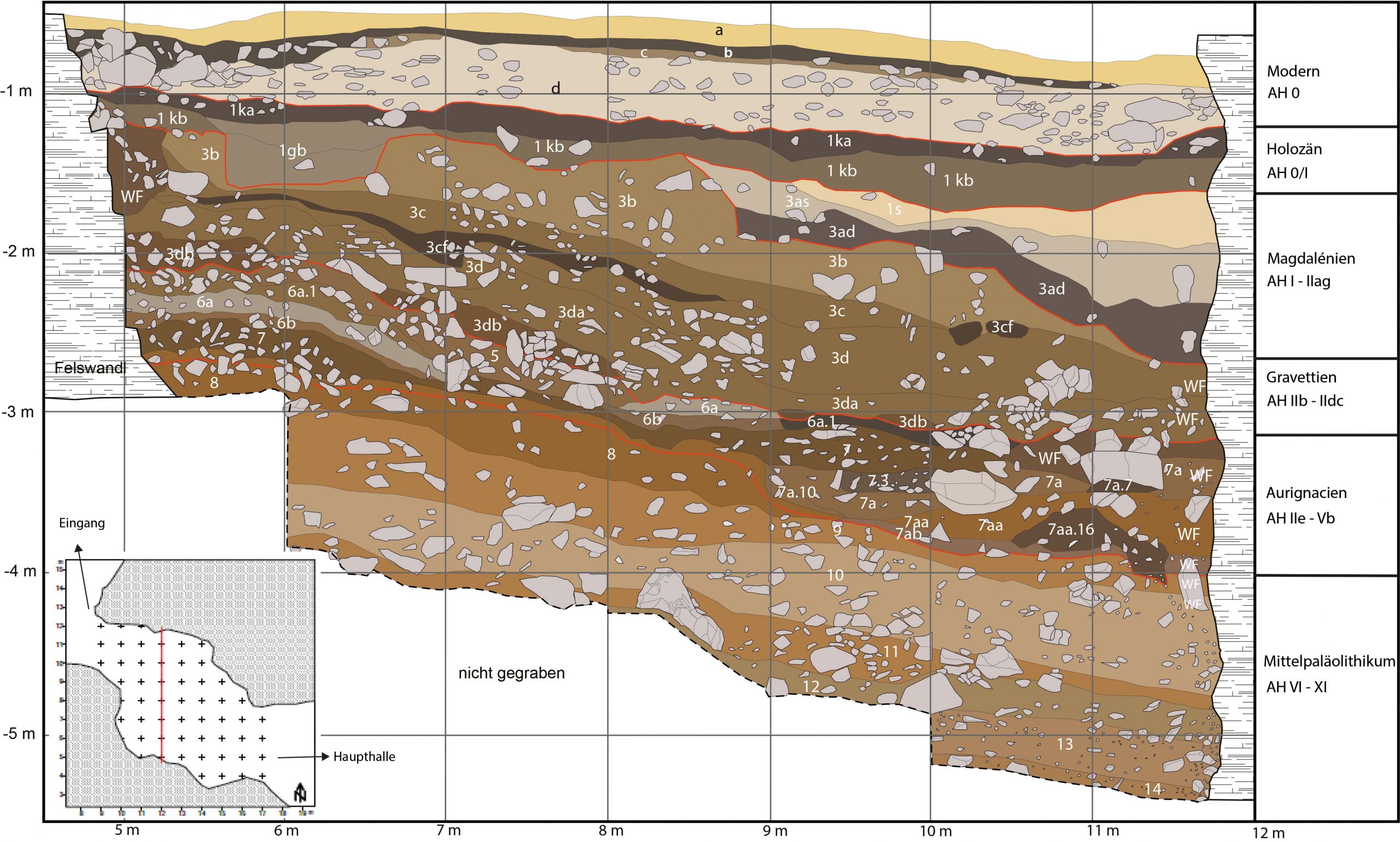
The new leaf point is made of locally available, gray Jurassic chert from the Swabian region (Fig. 2). The leaf point is 7.6 cm long, 4.1 cm wide, 0.9 cm thick and weighs 28 grams and falls in the size range of the two well-known leaf points from Riek’s excavation at Haldenstein Cave (Riek 1938). Riek’s excavation at Haldenstein in 1936 represents the only other example of leaf points being discovered in situ in the caves of the Swabian Jura, despite a rich history of excavation and intense research dating back to the 1860s. The excavation team recovered the new artifact from a clayey-silty matrix with fine limestone fragments and blocks of limestone debris with dimensions up to 20-30 cm. Abundant lithic artifacts and fragments of burnt bone and diverse faunal material were recovered in AH X, although, it should be underlined that the spatial scope of the deepest area of the excavation is currently limited to parts of six square meters in the northern area of the excavation. As has been reported earlier (Conard et al. 2012), the find densities of the overlying Middle Paleolithic find horizons are low and there appears to be an occupational hiatus between the youngest Middle Paleolithic of AH VI and the first Aurignacian occupation of the site. This paper presents a detailed functional study of the new leaf point and also discusses observations regarding the leaf points from Haldenstein Cave.
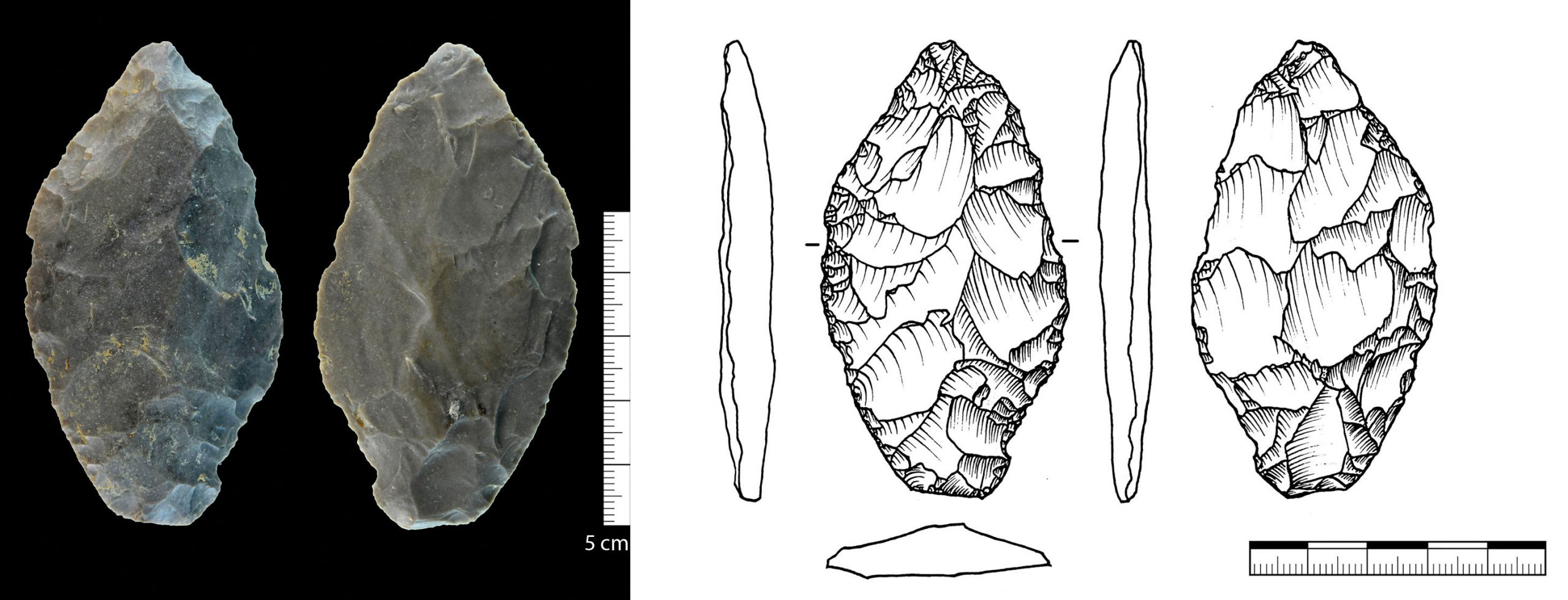
Context
Abundant faunal data exist that testify to regular hunting activities in the Middle Paleolithic, but limited data are available with regard to the exact hunting technologies used. There are the rare examples of preserved wooden spears, such as the one documented at Lehringen (Movius 1950; Jacob-Friesen 1956; Veil and Thieme 1985), and the well-known finds of Schöningen (Thieme 1997; Schoch et al. 2015) and Clacton-on-Sea (Oakley et al. 1977) demonstrate that this technology was already known before the Middle Paleolithic. Other finds, such as the wooden throwing sticks of Schöningen (Thieme 2007; Conard et al. 2020), further confirm the co-existence of different kinds of weapon from early on. No wooden throwing sticks have yet been documented for the Middle Paleolithic, but this may be due to issues related to preservation. While organic parts of hunting weapons are nearly absent for the Middle Paleolithic, detailed analysis of stone tools has yielded evidence for reconstructing hunting technology. Use-wear demonstrates that the mounting of stone points on shafts in view of hunting was known from at least about 250 ka onwards (e.g., Rots 2013), and a suitable method for the reliable identification of stone projectile points exists (cf. Rots and Plisson 2014). It is still difficult, however, to confirm the exact propulsion technique that was used. Even though claims for the supposed existence of the bow during the Middle Paleolithic have been made in recent publications (Sano et al. 2019), these claims are not supported by the use of reliable methods or appropriate experimental reference sets. The development of a methodology to identify the mode of propulsion on the basis of stone tool analysis is still in its infancy, but robust building blocks have been proposed over the last few years (Iovita et al. 2014; Coppe et al. 2019; Coppe et al. 2022).
Stone points identified as weapon tips remain limited in number and depend entirely on whether or not use-wear analysis was performed at the site. When such analyses have been performed, they regularly have revealed the existence of projectile points for Middle Paleolithic assemblages. For Western Europe, stone weapon tips have been identified on sites such as Biache-Saint-Vaast, Maastricht-Belvédère, Bettencourt and Sesselfelsgrotte through our own analyses (e.g., Rots 2009, 2013, 2015) and, for instance, at Angé (Soressi and Locht 2010; Locht et al. 2015), Fresnoy-au-Val and Beauvais (Coudenneau 2013), as proposed by other analysts. They nevertheless remain relatively limited in number and on average, not more than a handful of projectile points have been identified through functional analysis per site. The oldest evidence of triangular points used as projectile elements in the Near East is associated with Misliya Cave (around 200 ka) (Yaroshevich et al. 2016). Other possible projectile evidence is more recent and mainly concerns Levallois points, such as for Umm el Tlell (Boëda et al 1999), Kebara Cave (Shea 1988) and Hayonim Cave (Shea 1988) though some of this evidence has been debated (Plisson and Beyries 1998) and the reconstructed proportions of hafted projectile points vary greatly between authors (for the discussion see Plisson and Beyries 1998).
Leaf points take a particular position in the context of hunting weapons. On the whole, their analysis is more complicated as their bifacial morphology makes them more resistant to impact. In consequence, diagnostic damage or fracturing from impact is less likely to form and sometimes also more difficult to recognize against the invasive retouch.
Methods
We examined the leaf point from Hohle Fels with a stereoscopic microscope Zeiss V20 (magnifications up to x180) and with a metallurgical microscope Olympus BX51M (magnifications up to x1000). Pictures were taken with a Zeiss Axiocam 503 and with an Olympus DP10 camera, respectively. We examined residues with SEM-EDS (JEOL IT300).
We first systematically screened the leaf point for residues with the aid of the stereoscopic and metallurgical microscopes mentioned above. Their locations were registered and a possible association with wear features (e.g., damage) was evaluated. We subsequently examined all potentially functional residues with SEM-EDS in order to detect the chemical elements and evaluate their cause of deposition. Once this was completed, we cleaned the artifact with ethanol or acetone, as appropriate, in order to permit an examination for wear traces. If further residues were observed, a re-examination under the SEM-EDS was performed. All wear traces (polish, striations, damage, rounding) were systematically registered, and we devoted attention to the association between trace types, and when appropriate also residues. The patterning of the traces over the point was studied in detail in view of the interpretation of tool use, hafting and possible resharpening attempts.
Interpretations were based on TRAIL, the experimental reference library for traces and residues of TraceoLab, that consists of more than 5800 experimental stone tools (Rots 2010, 2021). A range of tasks are represented and tools have been used hand-held or hafted using different modes of hafting. TRAIL can thus be considered representative of a broad range of prehistoric activities. Other tools have been submitted to a range of human-induced or natural processes. TRAIL contains nearly 1000 points with varying morphologies that were used as armatures using different propulsion modes (e.g., Rots 2016; Coppe and Rots 2017; Coppe 2020). In addition to a number of experimental reference sets oriented towards specific archaeological case studies (e.g., Tomasso et al. 2015, 2018; Rots et al. 2017; Taipale et al. 2017; Tomasso and Rots 2018; de la Peña et al. 2018) and to particular issues related to projectiles (e.g., Rots 2016; Taipale and Rots 2019), the TRAIL reference library includes results from a systematic experiment using 555 stone points in three stone point morphologies (bifacial points, triangular points, backed points) in two size categories (Coppe and Rots 2017; Coppe 2020) propelled with different modes of propulsion. This extensive reference library thus served as a basis for the analysis of the leaf point from Hohle Fels.
While TRAIL contains a reference set for bifacial points of comparable size to the Hohle Fels Blattspitze (n = 47), their exact morphology and raw material do not really correspond (Table 1). Indeed, the Hohle Fels leaf point is broader and also slightly thinner than the reference points of TRAIL. With regard to the morphology of the tip, one has to take into account that the Hohle Fels leaf point is damaged, which may have significantly affected its angles. The current apical angle of the tip is at the lower end of the TRAIL reference collection, while the current zenithal angle of the Hohle Fels piece is clearly broader than those from the TRAIL library. While these differences have rather limited implications for the reliable identification of the use of the point, caution is required with regard to the identification of the propulsion mode, as this would require exact reproductions of the leaf point, ideally in the same raw material. Edge angles in particular play an important role with regard to the resistance to fracturing upon impact and thus affect the intensity of damage as well as aspects of the morphological features. Ten replicas of the Hohle Fels Blattspitze were made by an experienced knapper (C. Lepers, TraceoLab) in Harmignies flint (Belgium) to permit some explorative testing and to partially compensate for the aforementioned problems.
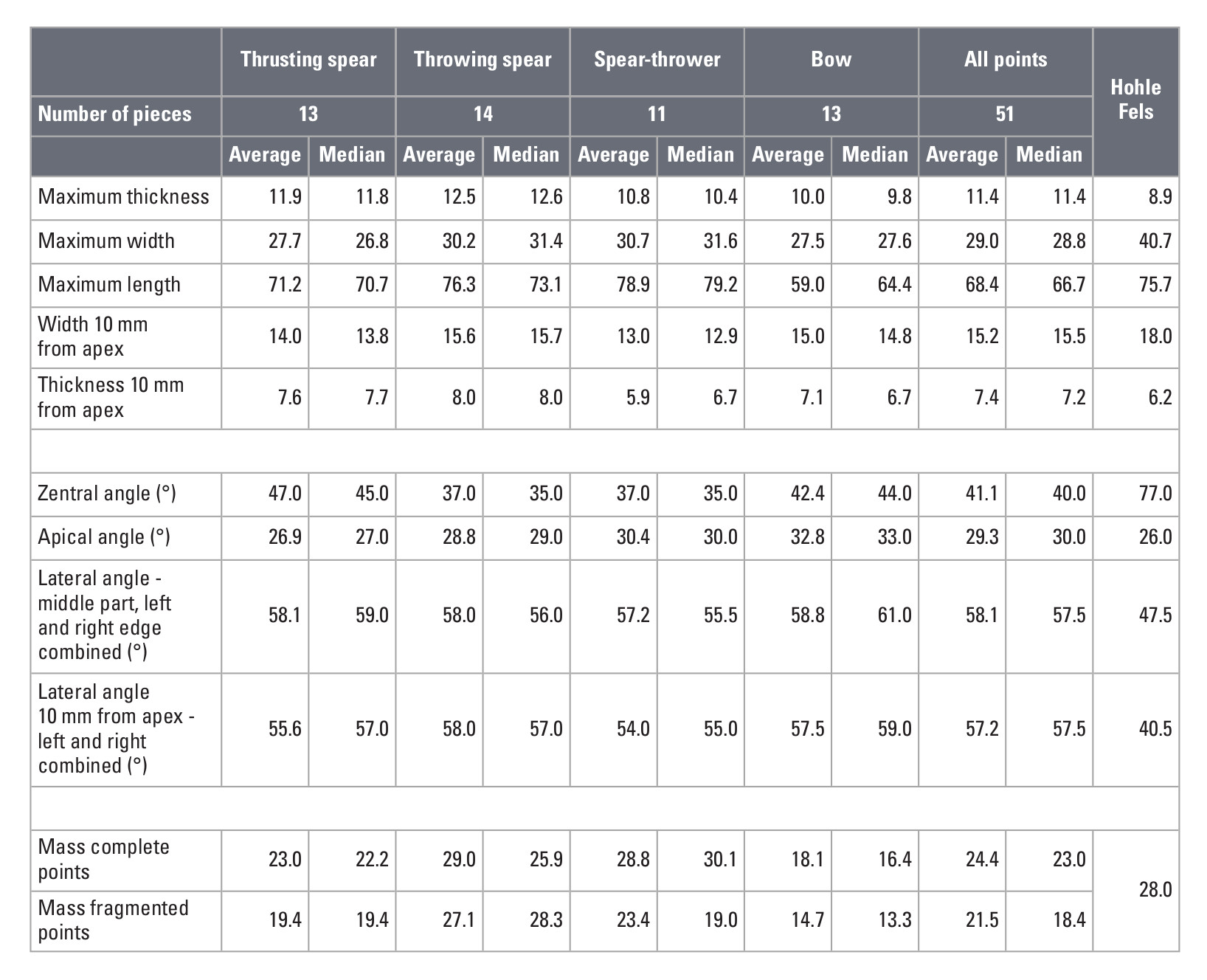
Bifacial points from the TRAIL library included in Table 1 were used with one out of four propulsion modes (thrusting, throwing, spear-thrower, bow) according to protocols outlined in Coppe and Rots (2017). They were shot into an artificial target composed of a complete pony skeleton encased in ballistic gel and covered with a stretched and remoistened pony hide (see Coppe and Rots 2017 for more details on the target used). Gestures used for propulsion and kinetic energies developed by each weapon system are detailed in Coppe et al. (2019). Bifacial points were re-used until a fracture occurred with a maximum of ten shots per point. As bifacial points are quite resistant to fracturing, 19 out of 47 points could be re-used more than once, but no point was used up to the maximum of ten times. Eleven points were shot twice, six points were shot three times, one point was shot five times, and one point was shot nine times. We recorded all fractures formed according to the registration proposed in Coppe and Rots (2017), although MLITs (i.e., Microscopic Linear Impact Trace) were not yet recorded on this experimental reference set.
Results
Morphology
The leaf point from Hohle Fels is bifacially worked over its entire surface and symmetrical in concept when viewed in plan-view, although this symmetry has been partially altered by resharpening (see below). The leaf point is asymmetrical when viewed laterally; it shows one rather flat surface, worked with invasive thin shaping flakes reaching over the central axis of the point, from which the opposite more convex face was produced with shaping flakes with a higher initiation angle and generally reaching up to the central axis of the artifact. The transversal cross-section of the piece is thus plano-convex, but with some minor variation. The proximal part of the tool tends a bit more towards a symmetrical transversal cross-section (biconvex) in comparison to the distal part. Resharpening of the distal part appears to have contributed to this morphology. In terms of the raw material used, the very small area of cortex that remains on one of the faces of the piece (cf. face B on Fig. 3) suggests that a flat cobble (or cortical flake) may have been used to make the leaf point. In addition, a specific effort was clearly invested in thinning the proximal part of the piece.
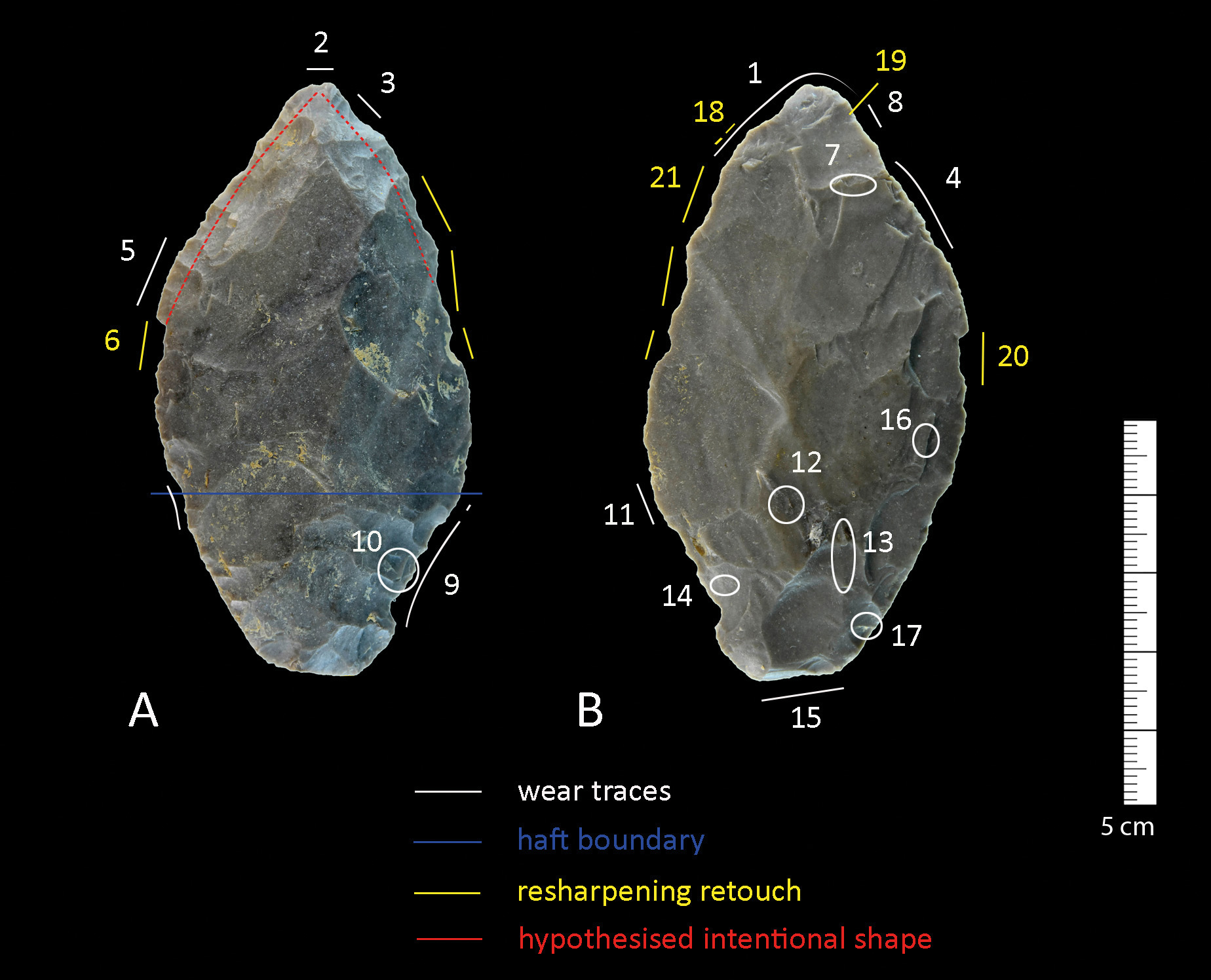
Tool use
Distinctive evidence of impact is visible on the tip and on the distal lateral edges of the tool (Fig. 3). The evidence consists of a combination of bending-initiated removals (Fig. 4), feather and step termination, some of which are associated with microscopic linear impact traces (MLITs) (Fig. 5) confirming that they originated from projectile impact (Rots and Plisson 2014). Several terminations are also associated with fissures which is an important feature as demonstrated in our experiments (e.g., Coppe 2020).
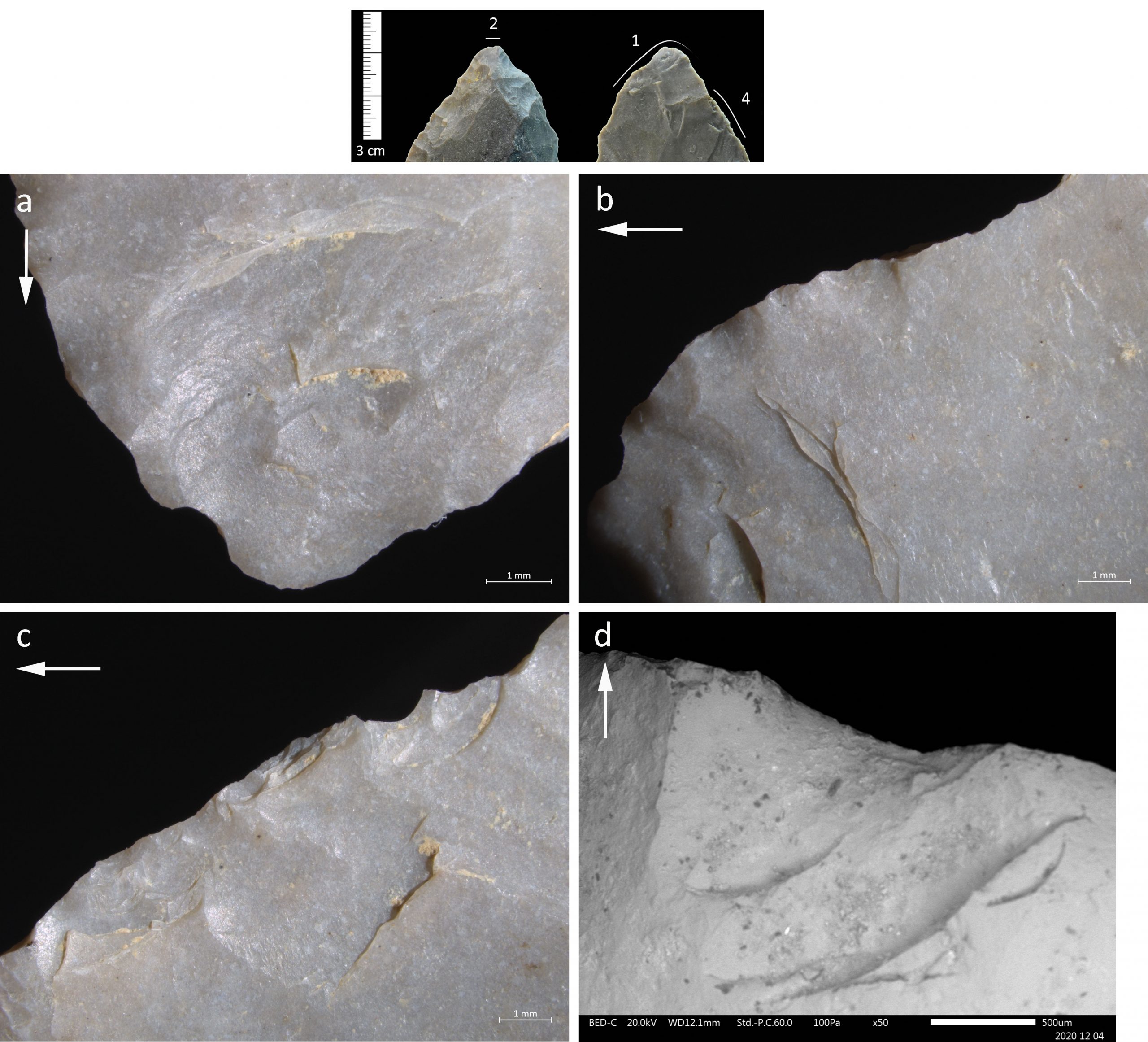
Diagnostic features in the wear traces and their patterning can be summarized as follows: On the distal end of the artifact, a combination of different bending initiated removals can be observed initiated by an axially oriented force (Fig. 3: 1, Fig. 4). A larger scar has a twisted initiation plane and a feather termination, and it is associated with two smaller and more laterally situated bending-initiated feather-terminating scars (Fig. 4). This scar is associated with a MLIT and possible residue was also observed. Under SEM analysis, this residue proved to be sediment. On the opposite surface (Fig. 3: 2), another larger bending initiated removal is visible on the apex and it shows a twisted initiation plane. Its initiation is axial and the removal is rather deep. The removal is rather short and it shows a step termination.
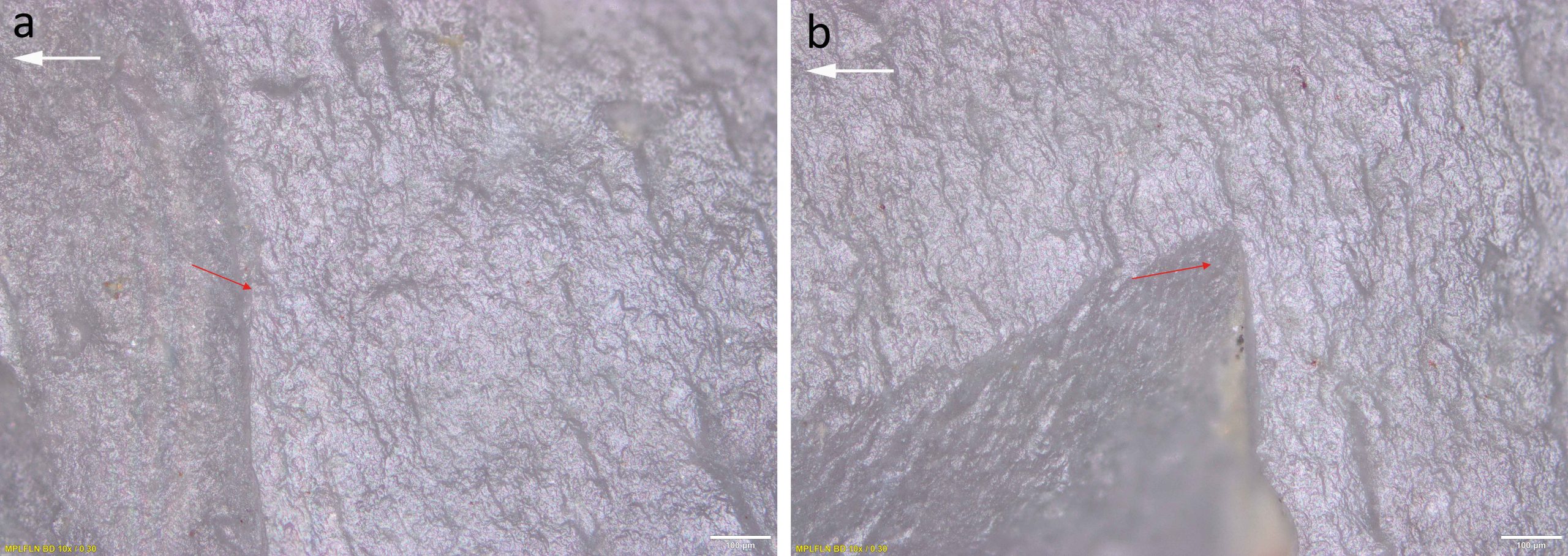
On the lateral edges close to the apex (Fig. 3: 3), additional bending initiated scars can be observed, regularly with a curved initiation profile and a succession of step terminations. In addition, a concentration of lateral removals as well as crushing (defined here as non-invasive superposing edge damage with hinge and step terminations) can be observed on the distal left lateral edge. These features remove the initiations of shaping negatives on the opposite face (Fig. 3: 4, Fig. 4: c) and are associated with MLITs (Fig. 6: a-b). This laterally damaged and crushed zone alternates with another crushed zone on the opposite face somewhat more proximal (Fig. 3: 5, Fig. 7: b). Just below, intentional retouch has removed all use-related wear and resulted in the creation of a notch and incipient cracks distal to the notch document unsuccessful strikes (Fig. 3: 6, Fig. 7: a).
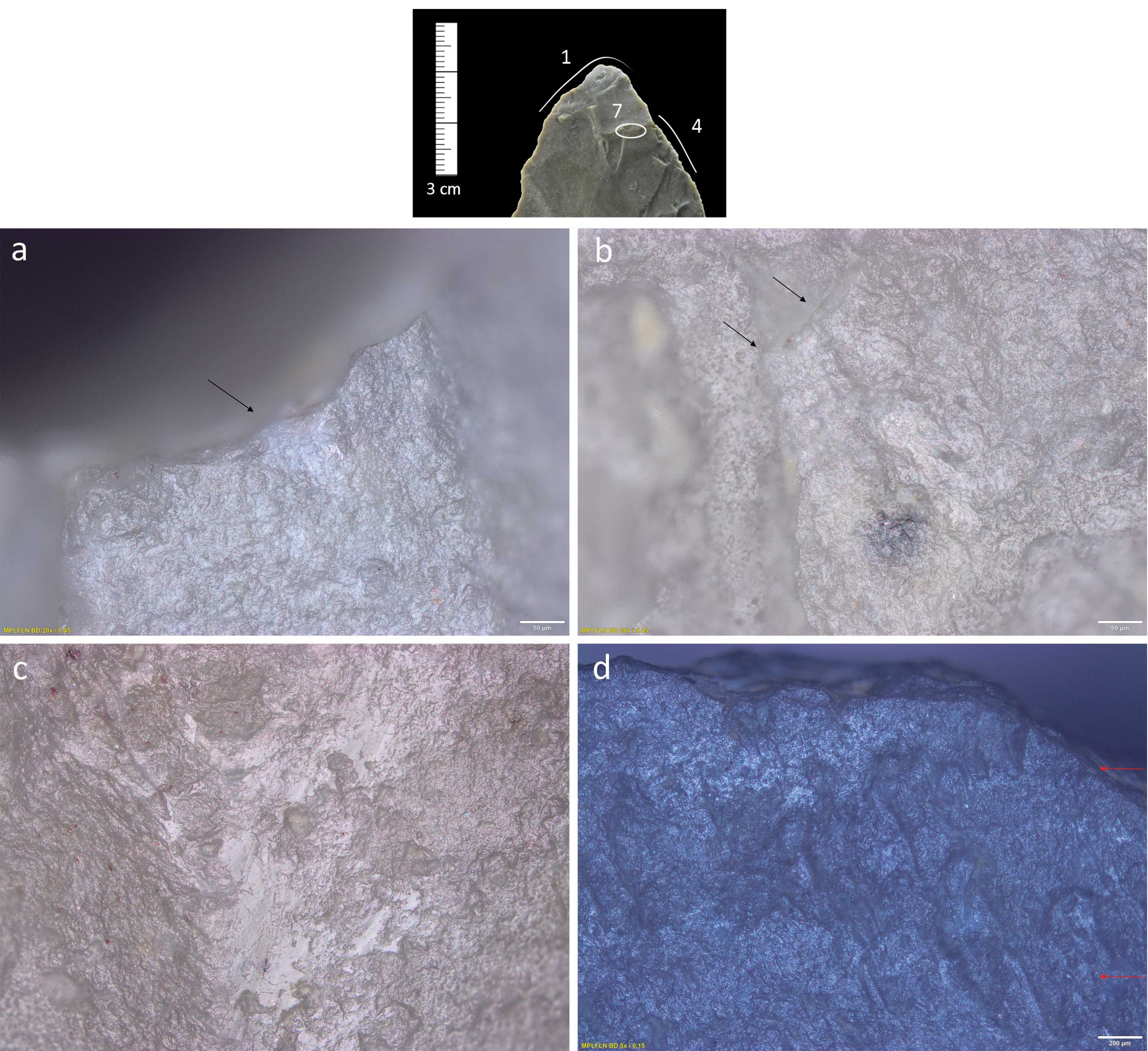
An intense concentration of frictional spots is visible on ridges in the apical zone and appears to testify an impact against bone (Fig. 3: 7, Fig. 6: c).
A few striations from use parallel to the edge and reflecting the direction of impact are visible close to one of the edges (Fig. 3: 8). This zone is part of a larger area with preserved use polish including slight edge rounding. It is one of the smaller areas in which impact on the edge remains visible and was not removed by resharpening.
The quantity of the evidence is remarkable given that bifacial edges are relatively robust and resistant against damage, as documented experimentally. While more demanding on the level of point production, a bifacial point may generally be considered as a reliable tool in hunting activities (Bleed 1986).
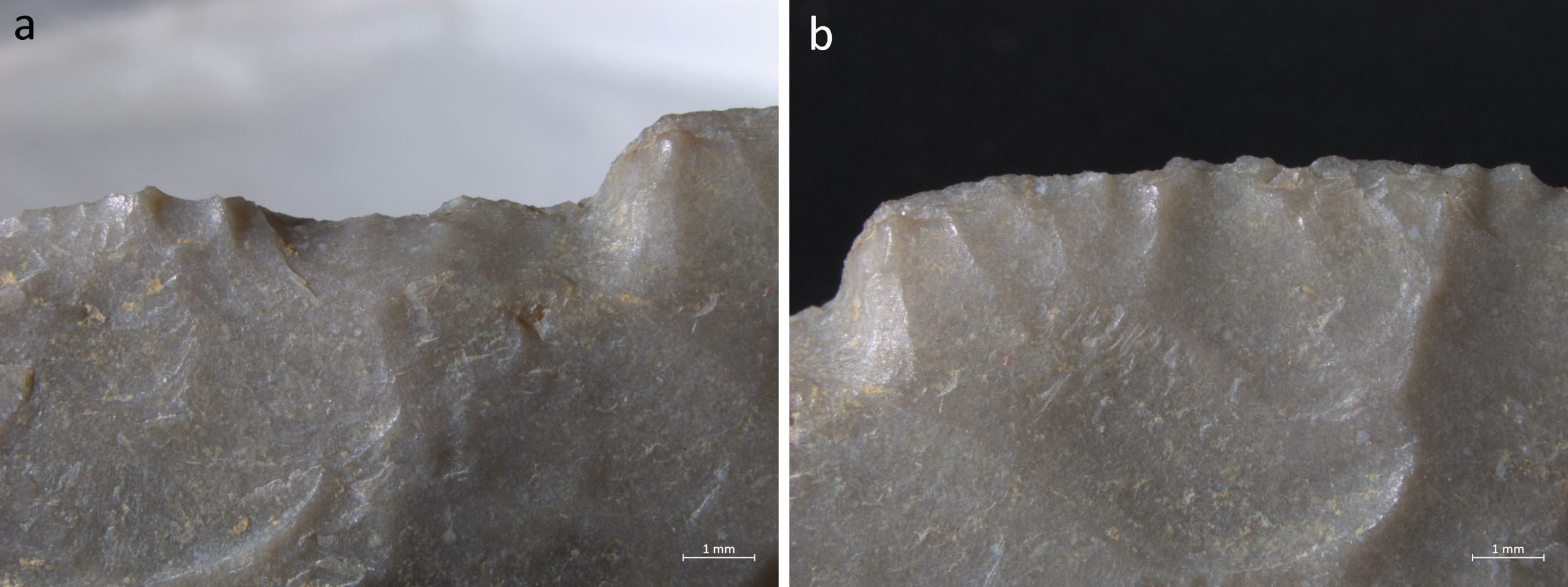
Hafting
Hafting evidence is clearly visible in the proximal part of the piece and consists of damage and frictional wear correlating with hafting wear (Rots 2010). Among other characteristics, the hafting wear consists of edge damage that is regularly bifacial. Also a rough polish associated with edge rounding could be observed in small areas. Part of the damage appears to be produced by counter-pressure within the hafting system, possibly during resharpening (see below) or alternatively impact (e.g., Fig. 3: 9). An intensively damaged zone, the aforementioned zone 9, is associated with localized friction spots in direct association with the damage (Fig. 3: 10, Fig. 8: a-b), which testifies the intense friction with raw material particles within the hafting system. This is a feature commonly observed in connection with hafting (Rots 2002, 2010).
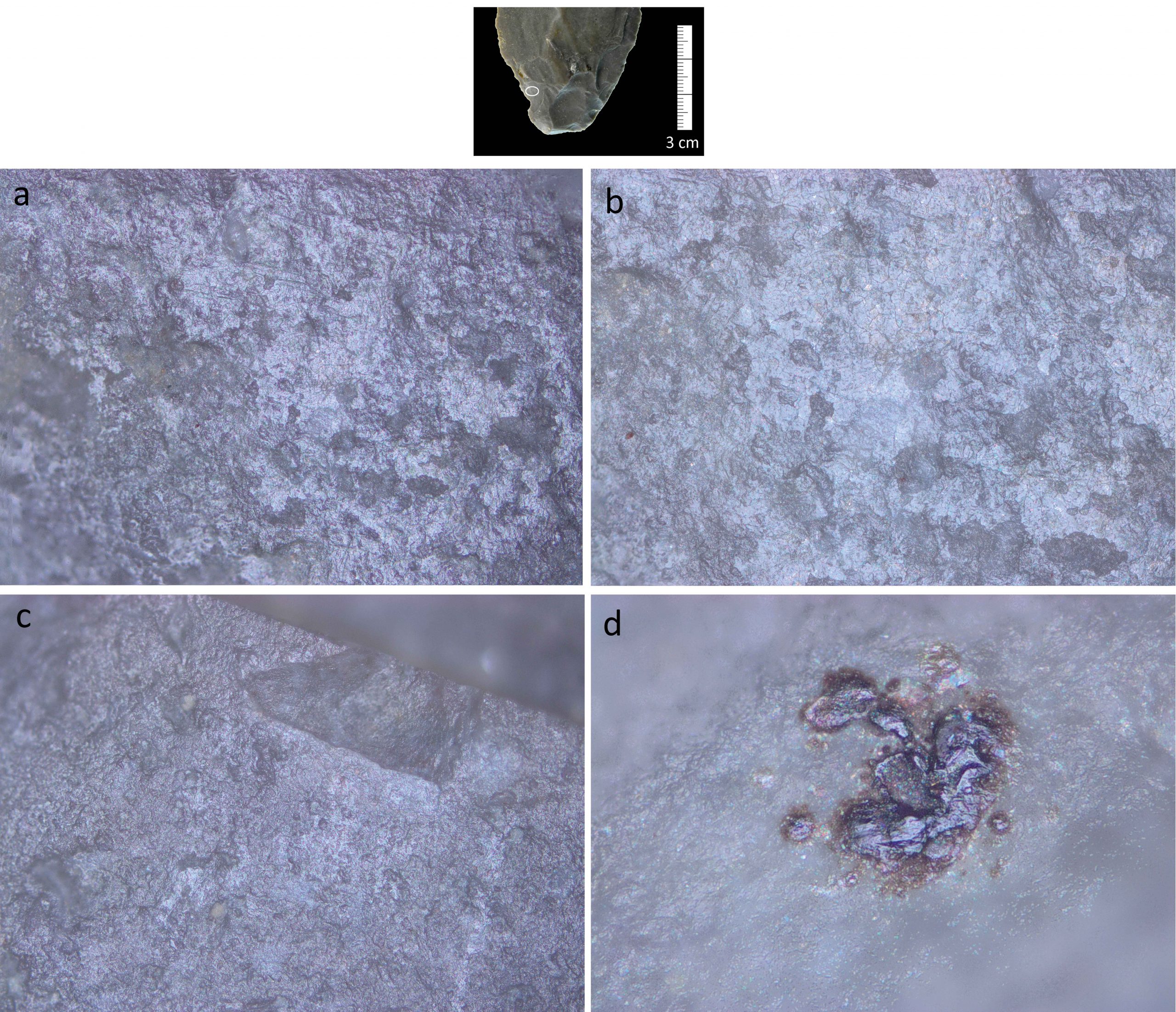
More dispersed frictional spots also occur close to one of the lateral edges around the haft boundary, which is again a typical feature. While taphonomic bright spots exist (Rots 2002), this is not a problem here as surface preservation is good overall and only light to moderate surface alteration is visible. On the opposite surface (Fig. 3: 11), crushing is located on the adjacent edge and a damage patch with scars showing twisted bending initiations and feather, hinge and step terminations are visible in a more proximal direction. The combination of features and their patterning tends to suggest that this feature corresponds with the hafting boundary.
We observed possible hair fibers in one area (Fig. 3: 12), but they could not be confirmed with SEM-EDS.
In the proximal part of the leaf point, in a prominent zone situated on the ridges (Fig. 3: 13), a concentration of linear features parallel to the axis is visible and it appears to be associated with partially destroyed residual plant structures. Some of the striations are very long.
On some terminations of shaping negatives, additional edge damage was initiated that is found together with striations, suggesting that it occurred within the haft (Fig. 3: 14, Fig. 8: c).
The large fracture on the proximal extremity is initiated in bending and probably occurred within the haft, either during impact or during resharpening (Fig. 3: 15). The latter is most likely given the absence of explicit associated friction wear, which would be the case if use of the piece continued after resharpening. The fracture may have loosened the piece in its hafting arrangement and may have contributed to the tool’s discard.
A few possible resinous remains were observed on the proximal surface (e.g., Fig. 8: d) which necessitated more in-depth study with SEM-EDS, as a first step (cf. Cnuts et al. 2018). For instance, possible spots were observed in the medial section (Fig. 3: 16) and proved to reveal an explicit Ca and P signal, which is suggestive of a possible bone residue (Fig. 9). No internal structure within this residue spot could be observed. Another spot slightly more proximal did show a cracked internal structure with a signal of Ca, P and Al and an associated fiber structure giving a signal of C, Ca, Al and P. The functional origin of these spots, however, is questionable given possible alternative taphonomic explanations. We also observed black spots in the most proximal zone where again a Ca+P signal could be identified under SEM. On the basis of other measurements on examined residues situated more proximally (Fig. 3: 17) and the residue morphology (e.g., a once-liquid appearance), both areas appear to reflect depositions of calcium phosphate and are thus likely of taphonomic origin. Possible plant residues were observed close to the latter residues in the proximal part (Fig. 3: 17). SEM-EDS revealed a residue with a clear plant structure, but it appears to be of taphonomic origin.
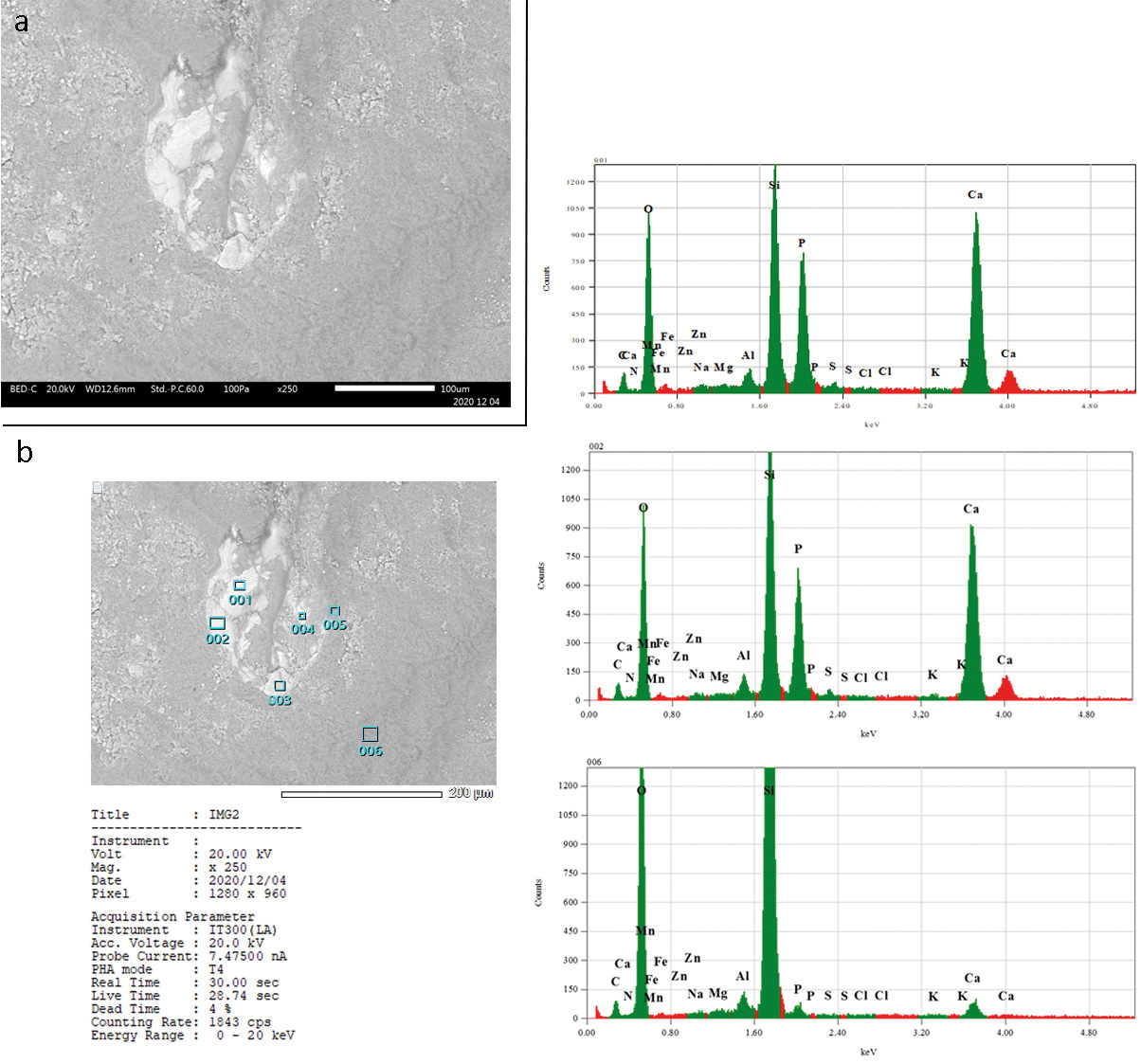
Residues that appear resinous under low magnification have been previously recorded on artifacts from the Gravettian layers of Hohle Fels. When analyzed with SEM-EDS, these deposits gave peaks of Ca and P but could not be confidently linked to tool hafting or use. Given that the cave sediments contain high levels of phosphates, particularly apatite-dahlite (Miller 2015), the residues have been tentatively interpreted as taphonomic in origin (Taipale 2020: 80-81, appendix 1).
Resharpening
In addition to extensive evidence for use, the tool also documents significant evidence of at least one important resharpening attempt. These resharpening removals partially cut through the use-wear by removing the initiations of impact-related damage, but resharpening remained incomplete. At several instances, an incipient crack around the initiation of the negative is visible and reflects the contact with the hammer (Fig. 10: b). These cracks are occasionally associated with a striation oriented perpendicular on the edge and reflect direct contact with the hammer (e.g., Fig. 3: 18-19, Fig. 10: a). The associated residue (Fig. 3: 19) proved to contain P and Ca, while the surrounding area did not show those elements (Fig. 11). This suggests that the piece may have been resharpened with a bone hammer. In addition, a possible fiber showing a C signal was found in association and could perhaps represent a collagen fiber, though this is uncertain. Also in the distal section (Fig. 3: 18), an incipient crack proved to be associated with a striation that revealed a chemical signal of mainly C, next to Ca and P, testifying to its organic origin. Again, the direct contact with the hammer may have led to the deposition of the residue.
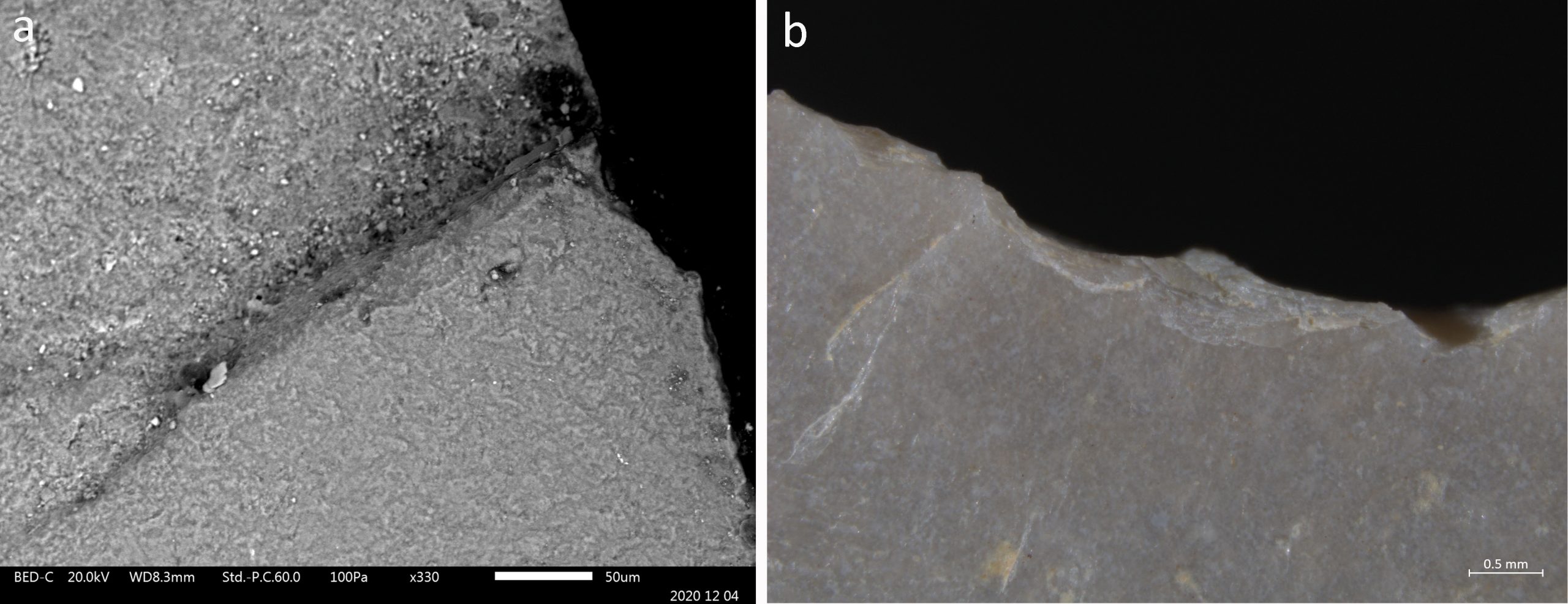
All wear evidence visible on the edges allows us to identify precisely where the knapper struck the leaf point in an attempt to reshape it. In between the successful strikes, the original tool edge with use-wear remains. This shows how the knapper tried to reshape the piece in view of continued use by removing or by compensating for the rather severe impact damage. Also incipient cracks document unsuccessful strikes (e.g., Fig. 3: 20). Since that resharpening proved unsuccessful, the knapper discarded the tool. This evidence for maintenance at a given moment in between use events corresponds to theoretical models with regard to reliable weapon systems (e.g., Bleed 1986), and bifacial points can definitely be considered reliable weapon types given their intense shaping and robustness.
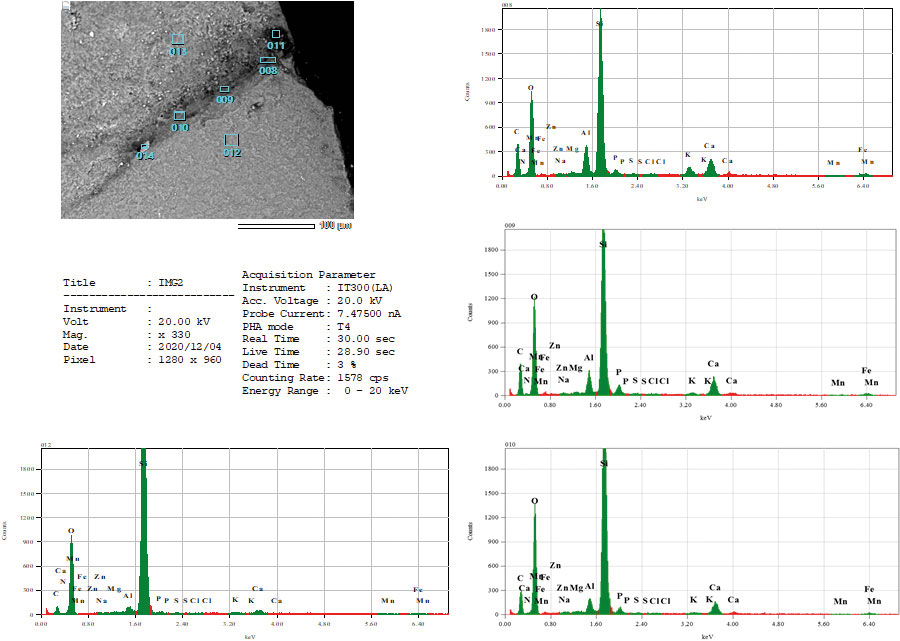
Origin of residue deposition
While the association of Ca and P with explicit functional wear features is definitely noteworthy, it is difficult to exclude that calcium phosphate may have formed on the surface due to taphonomic processes. This hypothesis was tested by systematically analyzing the residues themselves, the areas around the residue and by selecting multiple measuring points for EDS sampling. Outside the residue, P and Ca were either absent or only present in significantly smaller proportions suggesting that the higher concentrations could still reflect residues deposited by functional causes. However, through the analysis of multiple measuring points, Ca and P proved to be present with an extension that is beyond what one would assume to be purely functional, which suggests that the taphonomic deposition of calcium phosphate is real and needs to be accounted for. The formation of secondary apatite due to the interaction of phosphate from guano and calcium from ash has been discussed previously (Goldberg and Nathan 1975; Karkanas et al. 2000, 2002), also for Hohle Fels (Miller 2015). Nonetheless, even if the deposition of Ca and P were to be demonstrated as being taphonomic, the patterning of these deposits with its higher concentrations in some areas may still potentially witness a preferential deposition of P and Ca in zones where a functional residue was once located. A similar process has been observed with regard to manganese deposition following the presence of functional residues for the site of Ifri n’Ammar in Morocco (Tomasso et al. 2020). Such processes should be examined in more detail in the future. In the absence of a thorough understanding of the presence of calcium phosphates on other lithics in the same layers it is difficult to be entirely certain about the functional or taphonomic origin of the chemical elements identified on the tool. We hope to examine this question more closely in the future.
Interpretation
The leaf point discovered at Hohle Fels served as a projectile point used in hunting activities. Following intense use damage from impact on the edges, a resharpening session took place but the knapper did not succeed in renewing the edges. As a result, the point was likely discarded.
Comparison with experimental data from TRAIL
To determine the function of the new leaf point from Hohle Fels, we used the experimental set of 47 bifacial points from the TRAIL library discussed above (Fig. 12). While observed fractures are not described in detail here (details can be found elsewhere: Coppe 2020), we summarize them on two levels. We first evaluate the frequency of pieces with either no fracture, a single fracture or multiple fractures. The Hohle Fels point falls in the last category and it is clear that several experimental points witness combined fractures, independent of the mode of propulsion (Table 2). The number of fractures on the Hohle Fels piece testifies to its prolonged use life and its use until exhaustion.

Subsequently, we group all experimental fracture phenomena into three broad categories, namely breaks initiated in bending, fractures initiated from the tip and located on the lateral edge (otherwise referred to as burination), scarring initiated on the lateral edge. In addition, we register the association of these three fracture phenomena (i.e. primary) with secondary damage, i.e. damage initiated by one of the mentioned primary fractures. Such secondary damage is otherwise known as spin-offs (see Coppe and Rots 2017 for definitions). Also the occurrence of fissures at the termination of the fracture phenomena was examined (Table 3). Fissures prove to be associated with the terminations of bending breaks, lateral scars and secondary scars. Interestingly, secondary scars only prove to have occurred in association with bending breaks in this set.
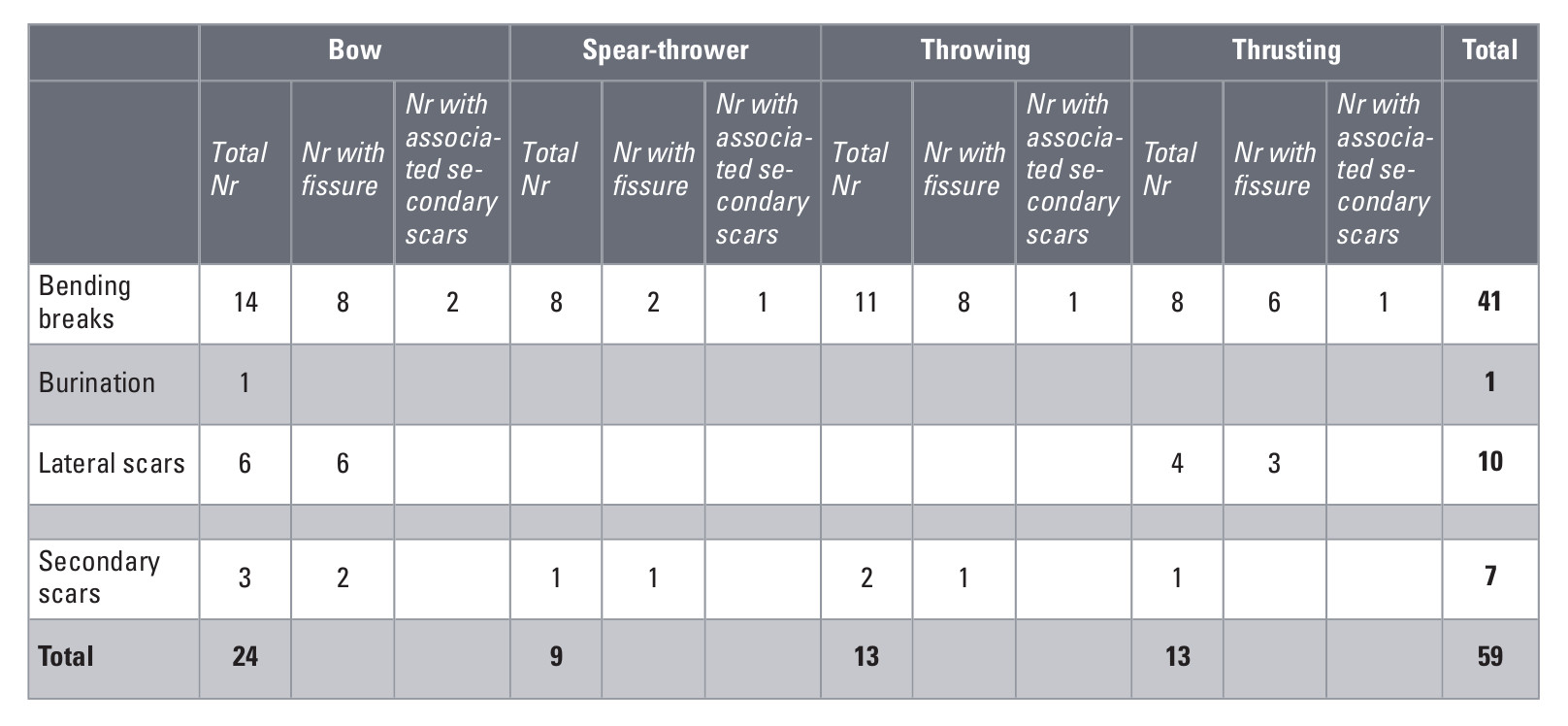
If we compare this to the Hohle Fels leaf point, we observe that both bending-initiated removals and lateral scars occur, while burinations are absent. Fissures are visible, in particular in association with the terminations of the large fracture phenomenon on the apex and the lateral scars. No secondary scars occurred on the Hohle Fels point.
We note that the relation of these fractures with possible MLITs could not be taken into account here as MLITs have not yet been registered in detail on the TRAIL reference set. This will be completed in the future. We emphasize that MLITs are present on the Hohle Fels point and form an integral part of the functional interpretation, but this aspect could not yet be considered in further detail with regard to hypotheses on the propulsion mode.
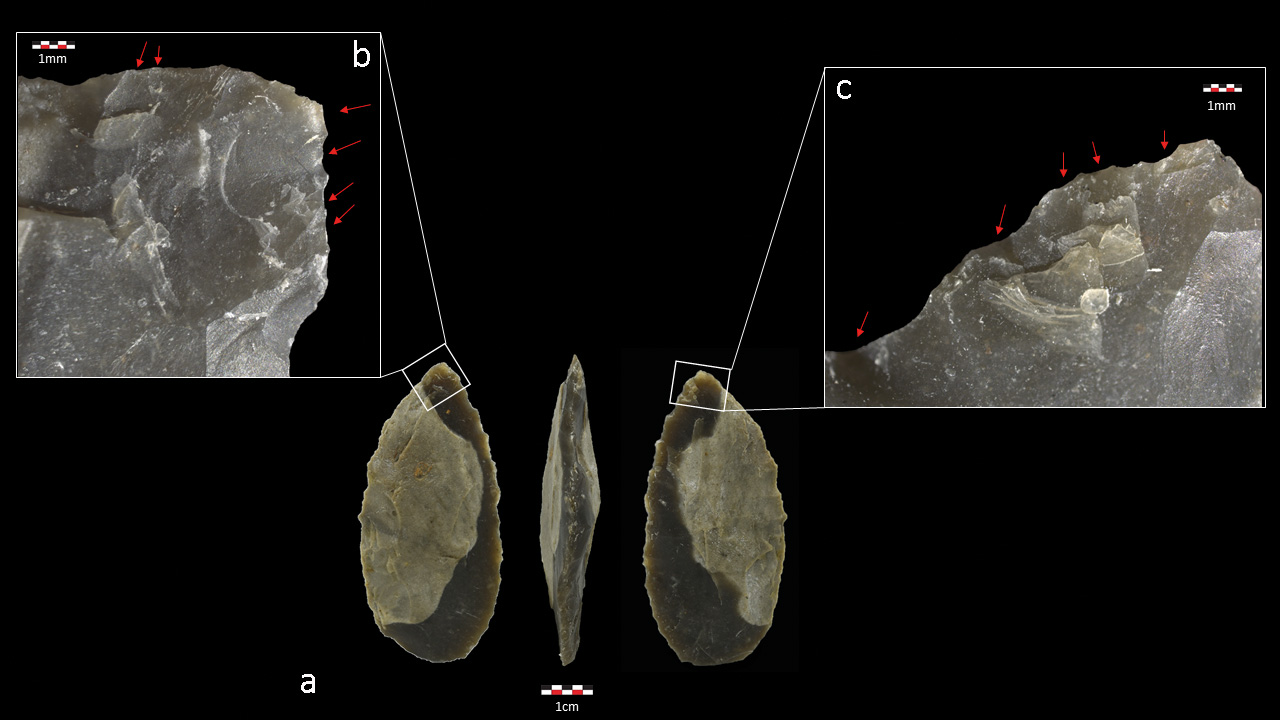
Hypotheses on possible propulsion modes of the Hohle Fels point
Any hypothesis on propulsion modes should be supported by a large body of experimental data in which the exact morphology of the studied tools is reproduced and different modes of propulsion are compared with regard to damage (e.g., Coppe 2020). In all other cases, only tentative hypotheses can be put forward and even these should be supported by at least some body of experimental data. In the absence of a systematic experimental program with exact reproductions of the Hohle Fels leaf point, we can only formulate tentative hypotheses on the basis of knowledge gained from studies of bifacial points of similar morphologies present in TRAIL.
The combination of tip damage with substantial damage on the lateral edges is suggestive for a prolonged high-pressure contact phase during impact, which correlates well with a use as thrusting spear (see also Coppe et al. 2019). Even though the presence of thrusting spear points in the Middle Paleolithic has previously been hypothesized (e.g., Shea 1998; Churchill and Rhodes 2009; Soressi and Locht 2010) or has been suggested based on wear evidence (Rots 2013), this leaf point is the first piece for which thrusting can be proposed as a likely propulsion mode on the basis of a large—though not perfectly representative—experimental reference set. This experimental reference was not yet available during previous analyses, thus limiting propositions on mode of propulsion mode to educated guesses. While a reliable identification of the mode of propulsion of the Hohle Fels leaf point would still require an adapted experimental program with exact reproductions of the leaf point and an exploration of all possible propulsion modes, combined with a systematic comparison of fracture frequencies and characteristics, current evidence permits us to propose thrusting as the most likely hypothesis. Ideally, any hypothesis on propulsion modes relies on a larger sample of points and not on a single find, but in the absence of more finds of leaf points at Hohle Fels, this is not possible.
If thrusting were to be confirmed as the mode of propulsion, it would imply close interaction between the hunter and the prey. The fracture pattern observed on the leaf point with the important lateral damage does not correspond to what has been observed on pieces propelled through other modes. Only the bow has been shown to lead to lateral damage in the case of bifacial points, but it also tends to lead to more significant damage overall, including secondary scars. This is not what has been observed on the Hohle Fels leaf point, where the damage features mainly separate, repeated impact events instead of combined fractures caused by a single impact, and no secondary scars were observed.
However, a critical note needs to be made. The leaf point shows limited shaping on one face and thus has a section that tends more towards being plano-convex rather than biconvex. This may have facilitated fractures in comparison to the pieces with higher edge angles like those from the TRAIL reference set. This further underlines that the use of the bow is very unlikely and that the thrusting spear hypothesis is best supported by the currently available evidence.
Comparison with two Blattspitzen from Haldenstein Cave
To gain more information on Middle Paleolithic leaf points from the Swabian caves, we examined the two leaf points from Riek’s dig at Haldenstein Cave (Riek 1938) based on a 3D scan and a printed 3D model. This significantly limits functional inferences, but it allows observation of some of the larger damage features on these artifacts. The damage visible on the apex of one of the Haldenstein leaf points (Fig. 13: a) suggests that this damage may have been caused by projectile impact though it is not diagnostic in itself. The other leaf point (Fig. 13: b) seems to have undergone a partial reshaping phase of its active extremity. Damage suggestive of hafting is visible on the proximal lateral edges and appears to mark a possible haft limit. Possible use-related damage is visible on the left distal edge and while its origin cannot be inferred with any certainty in the absence of direct microscopic observations, use as a projectile is possible. On the right distal edge, all evidence of use has been removed by reshaping, possibly to remove damage from an earlier phase of use. Reshaping also seems to have been initiated in the medial zone of the left edge but was interrupted. All these propositions remain tentative given the impossibility to verify them on the basis of microscopic evidence. The observed features nevertheless suggest that projectile function may not be restricted to the Hohle Fels piece and other leaf points may have been used in a similar manner.
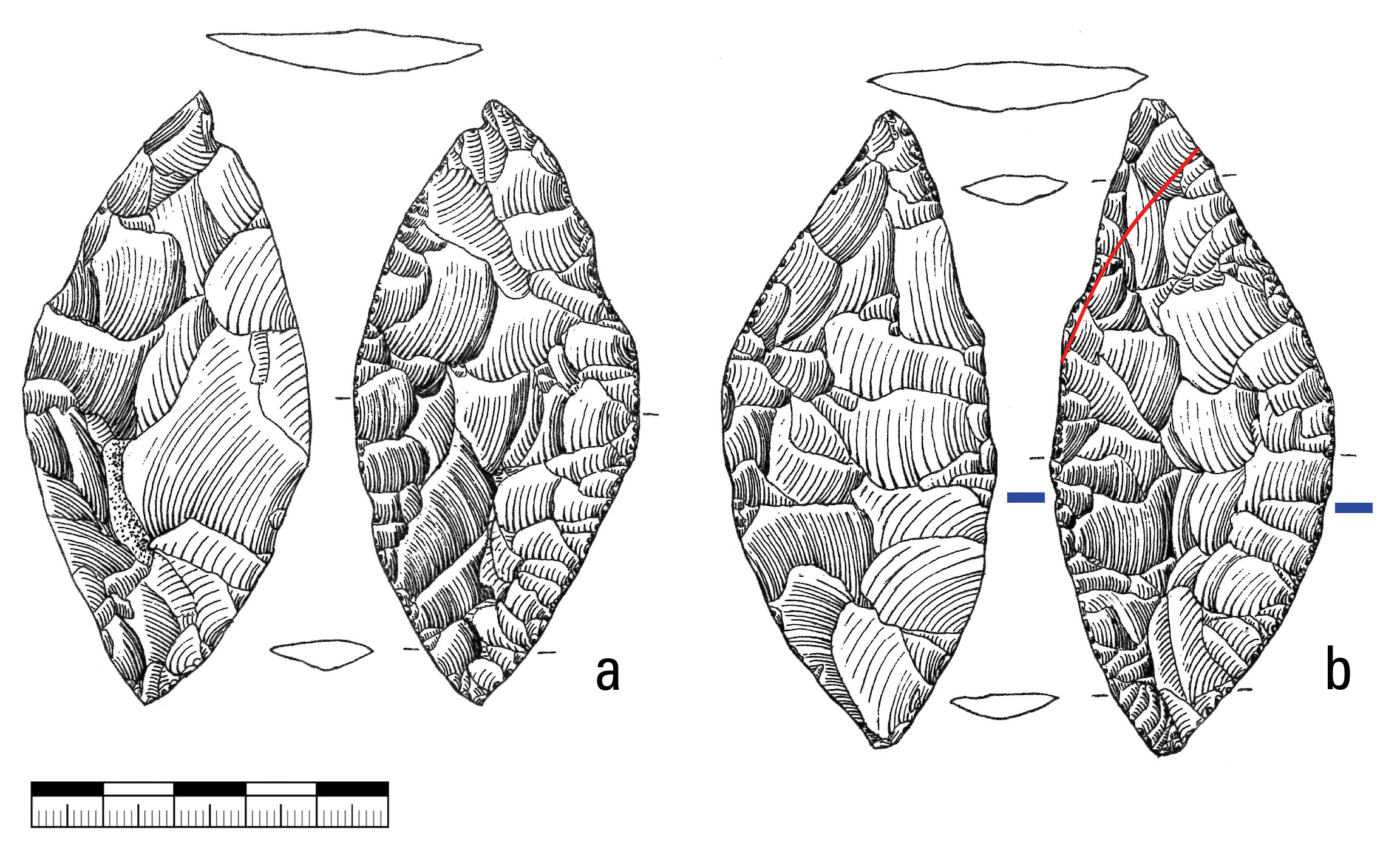
Discussion
Middle Paleolithic leaf points have only rarely been submitted to functional analysis, and the Hohle Fels piece is thus amongst the first for which a projectile function could be identified. While we are not yet certain of the exact mode of propulsion, the available evidence appears to favor the use of hafted leaf points as thrusting spears.
The use of thrusting spears in hunting is considered to date back to at least about 300 ka on the basis of the wooden spears discovered at Schöningen (Thieme 1997), one of which has been identified as a thrusting spear (Schoch et al. 2015). The Schöningen thrusting Spear VI is a pointed spear made from spruce wood with a length of 253.1 cm and a maximum diameter of 4.0 cm. As with the other Schöningen spears, no stone point was mounted at its extremity. Evidence for the use of stone spear points as tips on hunting weapons exists at different Middle Paleolithic sites (Locht et al. 2002; Soressi and Locht 2010; Coudenneau 2013; Rots 2013; Yaroshevich et al. 2016; Tomasso et al. 2020) and currently the oldest evidence dates to about 250 ka (Biache-Saint-Vaast, France: Rots 2013) even though a particular propulsion mode was not yet proposed in the absence of a sufficiently reliable experimental reference framework. Some of the wear evidence observed on lithic material from Maastricht-Belvédère in the Netherlands and Sesselfelsgrotte in southern Germany (Rots 2015) has also been interpreted as likely due to use in thrusting. The mode of propulsion in those studies was hypothesized on the recurrent observation of two separate wear patterns on the stone points, both of which were considered diagnostic for use in hunting activities. The authors argued that one of these likely reflected thrusting, while the other likely corresponded to a use as throwing spear (Rots 2015; see also Rots et al. 2011). For some of these sites, the results appear to imply that the two modes of propulsion co-existed.
Given the thermoluminescence date of 270 ± 22 ka for the site of Maastricht-Belvédère (Roebroeks 1988), the observed wear could imply that thrusting spears with hafted stone points appeared by this early date. While the interpretation of the mode of propulsion could not yet be supported by experimental evidence, continued experimentation strengthens the initial interpretation, although this should be examined more closely. For the leaf point from Hohle Fels, the wear pattern is explicit, and a comparison with the stone points in the existing experimental reference collection strongly suggests that this point was used in thrusting. The leaf point from Hohle Fels, dating to more than 60 ka BP, and the older evidence from Maastricht-Belvédère would suggest that hafted thrusting spears were possibly in, and perhaps sometimes out of use over long periods of time.
We argue that thrusting spears likely formed a standard part of hunting equipment and were used in combination with other kinds of weapons, be it throwing spears or other weapons. These results imply that one should not assume that all stone points identified as weapon tips on the basis of reliable evidence (see Rots and Plisson 2014 for a discussion) are necessarily propelled in the same way. Several kinds of weapons likely co-existed, and this aspect should be taken into account when analyzing stone points. This view has also been expressed in other studies (e.g., Tomasso et al. 2018; Conard et al. 2020). Even when spear-throwers or bows can be reliably argued to have been in use at a certain time and place, the possible existence of thrusting (or throwing) spears should not be forgotten. Thrusting spears may well have formed a standard part of weapon equipment over substantial periods, and the appearance of long-distance weaponry (no reliable evidence exists prior to the Solutrean: Cattelain 1989; see also Coppe et al. 2019 for a review) does not rule out the need for short-range weapons. Thrusting spears are known to have been part of hunting equipment throughout Antiquity (e.g., Barringer 2001), the Middle Ages and the Renaissance in Europe (e.g., Blackmore 2000), and they still exist in current hunting practices (e.g., Dira and Hewlett 2016). The co-existence of different kinds of weapons likely affects the composition of assemblages and the observed patterning, both in terms of morphologies and wear traces on stone points. This should be taken into account when searching for projectiles and when trying to approach propulsion modes.
For the site of Hohle Fels, we have so far presented only one point, and the co-existence of other kinds of weapons may well be demonstrated during continued functional analyses. For other Middle Paleolithic sites examined previously, such as Sesselfelsgrotte, a co-existence of thrusting spears with other weapon types, such as throwing spears, has already been hypothesized (Rots 2015; for evidence in Africa, see Rots et al. 2011). Also for an older site like Schöningen we have argued that the hunting gear consisted of a wide array of weapons including wooden throwing sticks together with wooden thrusting and throwing spears (Conard et al. 2020).
With the systematic study of the new leaf point from Hohle Fels and preliminary examination of the two leaf points from Haldenstein Cave we have demonstrated that these artifacts served primarily as projectiles used in hunting. At present it is not yet certain how these weapons were propelled exactly, and without a larger assemblage of artifacts it will not be easy to make such distinctions with a high level of confidence. The alternative hypothesis that the Blattspitzen of southwestern Germany also served as ulu-like knives (Müller-Beck 1983) is not consistent with our results and has been tentatively refuted.
This study is the first, but we hope not the last of its kind conducted on newly excavated Middle Paleolithic weaponry from the Swabian Caves, and we hope by following this line of research to eventually gain a more comprehensive view of the range of hunting equipment used by the Neanderthals who occupied the Swabian Jura before the arrival of modern humans in the region roughly 43 ka BP. Since the replacement of Neanderthals by modern humans is a demographic phenomenon, there is every reason to assume that part of the adaptive success of modern humans may be the result of a competitive advantage of these groups in the quest for food. As such an examination of the technology used for acquiring and processing food may well help to explain why modern humans spread quickly across Europe and replaced the indigenous Neanderthals at the beginning of the Upper Paleolithic. Information of this kind will also help to address the questions related to the role of increased symbolic communication via material culture during the Swabian Aurignacian in the spread of modern humans (Conard and Bolus 2003; Conard 2011, 2015). While health and fertility are directly related to a reliable high quality diet, the radical innovations in symbolic culture including personal ornaments with a man-made form, figurative art, mythical imagery and musical instruments likely also made direct or indirect contributions to the biological fitness of our species and helped modern humans gradually to replace all archaic hominins across the Old World.
Acknowledgments
We acknowledge the support of Christian Lepers at TraceoLab, University of Liège, in performing the experimental work. Veerle Rots and Justin Coppe are indebted to the FNRS for the financial support of their research. We are grateful to Alexander Janas and the field crew of Hohle Fels for their essential contributions to this research. The excavation at Hohle Fels is funded by Heidelberg Cement, the Ministry of Science, Research and Art of Baden-Württemberg, the project the Role of Culture in Early Expansions of Humans of the Heidelberg Academy of Sciences and Humanities, and the University of Tübingen. We are particularly indebted to Michael Bolus, Benjamin Schürch and Noora Taipale for their critical remarks to an earlier version of this paper.
References
Allsworth-Jones, P. 1986: The Szeletian and the Transition from Middle to Upper Palaeolithic in Central Europe. Oxford: Clarendon Press.
Barringer, J. M. 2001: The hunt in ancient Greece. Baltimore, Maryland: Johns Hopkins University Press.
Bataille, G. and Conard, N. J. 2018: Blade and bladelet production at Hohle Fels Cave, AH IV in the Swabian Jura and its importance for characterizing the technological variability of the Aurignacian in Central Europe. PLoS ONE 13(4): e0194097.
Blackmore, H. L. 2000: Hunting Weapons: From the Middle Ages to the Twentieth Century. New York: Dover Publications.
Bleed, P. 1986: The optimal design of hunting weapons: maintainability or reliability. American Antiquity 51, 737-747.
Boëda, E., Geneste, J. M., Griggo, C., Mercier, N., Muhesen, S., Reyss, J. L., Tahas, A., and Valladas, H. 1999: A Levallois point embedded in the vertebra of a wild ass (Equus africanus): Hafting, projectiles and Mousterian hunting weapons. Antiquity 73, 394-402.
Bolus, M. 2004a: Der Übergang vom Mittel- zum Jungpaläolithikum in Europa. Eine Bestandsaufnahme unter besonderer Berücksichtigung Mitteleuropas. Germania 82, 1-54.
Bolus, M. 2004b: Settlement Analysis of Sites of the Blattspitzen Complex in Central Europe. In: N. J. Conard (ed.), Settlement Dynamics of the Middle Paleolithic and Middle Stone Age II. Tübingen Publications in Prehistory. Tübingen: Kerns Verlag, 201-226.
Bolus, M. 2018: Blattförmige Schaber, Limaces, Blattspitzen. In: H. Floss (ed.), Steinartefakte. Vom Altpaläolithikum bis in die Neuzeit. Third edition. Tübingen: Kerns Verlag, 309-326.
Bosinski, G. 1967: Die mittelpaläolithischen Funde im westlichen Mitteleuropa. Fundamenta A/4. Köln/Graz: Böhlau Verlag.
Cattelain, P. 1989: Un crochet de propulseur solutréen de la grotte de Combe-Saunière 1 (Dordogne). Bulletin de la Société préhistorique française 86, 213-216.
Churchill, S. E. and Rhodes, J. A. 2009: The Evolution of the Human Capacity for “Killing at a Distance”: The Human Fossil Evidence for the Evolution of Projectile Weaponry. In: J.-J. Hublin and M. P. Richards (eds.), The Evolution of Human Diets. Integrating Approaches to the Study of Palaeolithic Subsistence. Dordrecht: Springer, 201-210.
Cnuts, D., Tomasso, S., and Rots, V. 2018. The Role of Fire in the Life of an Adhesive. Journal of Archaeological Method and Theory 25, 839-862.
Conard, N. J. 2009: A female figurine from the basal Aurignacian of Hohle Fels Cave in southwestern Germany. Nature 459, 248-252.
Conard, N. J. 2011: The Demise of the Neanderthal Cultural Niche and the Beginning of the Upper Paleolithic in Southwestern Germany. In: N. J. Conard and J. Richter (eds.), Neanderthal Lifeways, Subsistence and Technology: One Hundred Fifty Years of Neanderthal Study. Heidelberg: Springer, 223-240.
Conard, N. J. 2015: Cultural Evolution during the Middle and Late Pleistocene in Africa and Eurasia. In: W. Henke and I. Tattersall (eds.), Handbook of Paleoanthropology, 2nd edition. Berlin: Springer, 2465-2508.
Conard, N. J. and Bolus, M. 2003: Radiocarbon dating the appearance of modern humans and timing of cultural innovations in Europe: new results and new challenges. Journal of Human Evolution 44, 331-371.
Conard, N. J. and Bolus, M. 2006: The Swabian Aurignacian and its Place in European Prehistory. In: O. Bar-Yosef and J. Zilhão (eds.), Towards a Definition of the Aurignacian. Trabalhos de Arqueologia 45. Lisboa: American School of Prehistoric Research/Instituto Português de Arqueologia, 211-239.
Conard N. J. and Fischer B. 2000: Are There Recognizable Cultural Entities in the German Middle Palaeolithic? In: A. Ronen and M. Weinstein-Evron (eds.), Toward Modern Humans. The Yabrudian and Micoquian 400-50 k-years ago. BAR International Series 850. Oxford BAR Publishing, 7-21.
Conard, N. J. and Janas, A. 2021: Ausgrabungen im Hohle Fels: Fundschichten aus dem Mittelpaläolithikum und Neues zur Jagdtechnik der Neandertaler. Archäologische Ausgrabungen in Baden-Württemberg 2020, 60-65.
Conard, N. J., Malina, M., and Münzel, S. C. 2009: New flutes document the earliest musical tradition in southwestern Germany. Nature 460, 737-740.
Conard, N. J., Bolus M., and Münzel, S. C. 2012: Middle Paleolithic land use, spatial organization and settlement intensity in the Swabian Jura, southwestern Germany. Quaternary International 247, 236-245.
Conard, N. J., Serangeli, J., Bigga, G., and Rots, V. 2020: A 300,000-year-old throwing stick from Schöningen, northern Germany, documents the evolution of human hunting. Nature Ecology & Evolution 4, 690-693.
Conard, N. J., Janas, A., Richard, M., Schürch, B., and Tribolo, C. 2021: The cultural and chronostratigraphic context of a new leaf point from Hohle Fels Cave in the Ach Valley of southwestern Germany. Mitteilungen der Gesellschaft für Urgeschichte 30.
Coppe, J. 2020: Sur les traces de l’armement préhistorique: Mise au point d’une méthode pour reconstruire les modes d’emmanchement et de propulsion des armatures lithiques par une approche expérimentale, mécanique et balistique. PhD thesis, Université de Liège.
Coppe, J. and Rots, V. 2017: Focus on the target. The importance of a transparent fracture terminology for understanding projectile points and projecting modes. Journal of Archaeological Science: Reports 12, 109-123.
Coppe, J., Lepers, C., Clarenne, V., Delaunois, E., Pirlot, M., and Rots, V. 2019: Ballistic Study Tackles Kinetic Energy Values of Palaeolithic Weaponry. Archaeometry 61, 933-956.
Coppe, J. Lepers, C., and Rots V. submitted. Projectiles under a new angle. A ballistic analysis aiming to grasp Paleolithic weapon technology.
Coudenneau, A. 2013: Éléments triangulaires et armes de chasse au Paléolithique moyen. Constats et réflexions à travers l’étude techno-morpho-fonctionnelle de quatre séries d’Europe occidentale. PhD thesis, Université Aix-Marseille.
de la Peña, P., Taipale, N., Wadley, L., and Rots, V. 2018: A techno-functional perspective on quartz micro-notches in Sibudu’s Howiesons Poort indicates the use of barbs in hunting technology. Journal of Archaeological Science 93, 166-195.
Dira, S. J. and Hewlett, B. S. 2016: Learning to Spear Hunt Among Ethiopian Chabu Adolescent Hunter-Gatherers. In: H. Terashima and B. S. Hewlett (eds.), Social Learning and Innovation in Contemporary Hunter-Gatherers. Replacement of Neanderthals by Modern Humans Series. Tokyo: Springer, 71-81.
Flas, D. 2000-2001: Étude de la continuité entre le Lincombien-Ranisien-Jerzmanowicien et le Gravettien aux pointes pédonculées septentrional. Préhistoire Européenne 16-17, 163-189.
Freund, G. 1952: Die Blattspitzen des Paläolithikums in Europa. Quartär-Bibliothek 1. Bonn: Ludwig Röhrscheid Verlag.
Goldberg, P. and Nathan, Y. 1975: The Phosphate Mineralogy of et-Tabun Cave, Mount Carmel, Israel. Mineralogical Magazine 40, 253-258.
Hardy, B. L., Kay, M., Marks, A. E., and Monigal, K. 2001: Stone tool function at the paleolithic sites of Starosele and Buran Kaya III, Crimea: Behavioral implications. Proceedings of the National Academy of Sciences of the U.S.A. 98, 10972-10977.
Higham, T., Basell, L., Jacobi, R., Wood, R., Bronk Ramsey, C., and Conard, N. J. 2012: Τesting models for the beginnings of the Aurignacian and the advent of figurative art and music: The radiocarbon chronology of Geißenklösterle. Journal of Human Evolution 62, 664-676.
Hopkinson, T. 2004: Leaf points, landscapes and environment change in the European late Middle Palaeolithic. In: N. J. Conard (ed.), Settlement Dynamics of the Middle Paleolithic and Middle Stone Age II. Tübingen: Kerns Verlag, 227-258.
Iovita, R., Schönekeß, H., Gaudzinski-Windheuser, S., and Jäger, F. 2014: Projectile impact fractures and launching mechanisms: Results of a controlled ballistic experiment using replica Levallois points. Journal of Archaeological Science 48, 73-83.
Jacob-Friesen, K. H. 1956: Eiszeitliche Elefantenjäger in der Lüneburger Heide. Jahrbuch des RGZM 3, 1-22.
Karkanas, P., Bar-Yosef, O., Goldberg, P., and Weiner, S. 2000: Diagenesis in Prehistoric Caves: the Use of Minerals that Form In Situ to Assess the Completeness of the Archaeological Record. Journal of Archaeological Science 27, 915-929.
Karkanas, P., Rigaud, J.-P., Simek, J. F., Albert, R. M., and Weiner, S. 2002: Ash Bones and Guano: A Study of the Minerals and Phytoliths in the Sediments of Grotte XVI, Dordogne, France. Journal of Archaeological Science 29, 721-732.
Locht, J. L., Swinnen, C., Révillion, S., and Caspar, J. P. 2002: Les occupations du Paléolithique moyen. In: J. L. Locht (ed.), Bettencourt-Saint-Ouen (Somme). Cinq Occupations paléolithiques au début de la dernière glaciation. Paris: Editions de la Maison des sciences de l’Homme 57-145.
Locht, J.-L., Coutard, S., Soressi, M., Kiefer, D., Koehler, H., and Debenham, N. 2015: Angé (Loir-et-Cher): un site moustérien à influences multiples. In: P. Depaepe, E. Goval, H. Koehler, and J.-L. Locht (eds.), Les plaines du Nord-Ouest. Carrefour de l’Europe au Paléolithique moyen ? Actes de la table ronde d’Amiens, 28-29 mars 2008. Mémoires de Société Préhistorique Française 59. Paris: Société Préhistorique Française, 101-125.
Miller, C. E. 2015: A Tale of Two Swabian Caves. Geoarchaeological Investigations at Hohle Fels and Geiβenklösterle. Tübingen: Kerns Verlag.
Movius, H. L., Jr. 1950: A wooden spear of third interglacial age from lower Saxony. Journal of Anthropological Research 6, 139-142.
Müller-Beck, H. 1983: Sammlerinnen und Jäger von den Anfängen bis vor 35 000 Jahren. In: H. Müller-Beck (ed.), Urgeschichte in Baden-Württemberg. Stuttgart: Konrad Theiss Verlag, 241-272.
Oakley, K. P., Andrews, P., Keeley, L. H., and Desmond, J. C. 1977: A reappraisal of the Clacton spearpoint. Proceedings of the Prehistoric Society 43, 13-30.
Plisson, H. and Beyries, S. 1998: Pointes ou outils triangulaires? Données fonctionnelles dans le Moustérien levantin. Paléorient 24(1), 5-24.
Riek, G. 1938: Ein Beitrag zur Kenntnis des süddeutschen Solutréen. Germania 22, 147-50.
Roebroeks, W. 1988. From Find Scatters to Early Hominid Behaviour: A Study of Middle Palaeolithic Riverside Settlements at Maastricht-Belvédère (The Netherlands). Analecta Praehistorica Leidensia 21. Leiden: University of Leiden.
Rots, V. 2002: Hafting traces on flint tools: possibilities and limitations of macro-and microscopic approaches. PhD thesis, KU Leuven.
Rots, V. 2009: The functional analysis of the Mousterian and Micoquian assemblages of Sesselfelsgrotte, Germany: Aspects of tool use and hafting in the European Late Middle Paleolithic, Quartär 56, 37-66.
Rots, V. 2010: Prehension and Hafting Traces on Flint Tools. A Methodology. Leuven: Leuven University Press.
Rots, V. 2013: Insights into early Middle Palaeolithic tool use and hafting in Western Europe. The functional analysis of Level IIa of the early Middle Palaeolithic site of Biache-Saint-Vaast (France). Journal of Archaeological Science 40, 497-506.
Rots, V. 2015: Hafting and the interpretation of site function in the European Middle Palaeolithic. In: N. Conard and A. Delagnes (eds.), Settlement Dynamics of the Middle Palaeolithic and Middle Stone Age IV. Tübingen: Kerns Verlag, 383-410.
Rots, V. 2016: Projectiles and hafting technology, In: R. Iovita and K. Sano (eds.), Multidisciplinary Approaches to the Study of Stone Age Weaponry. Vertebrate Paleobiology and Paleoanthropology Series. Dordrecht: Springer, 167-185.
Rots, V. 2021: TRAIL. An Experimental Trace and Residue Reference Library for the functional analysis of stone tools in Liège. OSF Preprints. April 26. doi:10.31219/osf.io/jsak6.
Rots, V. and Plisson, H. 2014: Projectiles and the abuse of the use-wear method in a search for impact. Journal of Archaeological Science 48, 154-165.
Rots, V., Van Peer, P., and Vermeersch, P. M. 2011: Aspects of Tool Production, Use and Hafting in Palaeolithic industries from Northeast Africa. Journal of Human Evolution 60, 637-664 (with supplementary online material).
Rots, V., Lentfer, C., Schmid, V. C., Porraz, G., and Conard, N. J. 2017: Pressure flaking to serrate bifacial points for the hunt during the MIS5 at Sibudu Cave (South Africa). PloS ONE 12(4): e0175151.
Sano, K., Arrighi, S., Stani, C., Aureli, D., Boschin, F., Fiore, I., Spagnolo, V., Ricci, S., Crezzini, J., Boscato, P., Gala, M., Tagliacozzo, A., Birarda, G., Vaccari, L., Ronchitelli, A., Moroni, A., and Benazzi, S. 2019: The earliest evidence for mechanically delivered projectile weapons in Europe. Nature Ecology & Evolution 3(10), 1409-1414.
Schoch, W. H., Bigga, G., Böhner, U., Richter, P., and Terberger, T. 2015: New insights on the wooden weapons from the Paleolithic site of Schöningen. Journal of Human Evolution 89, 214-225.
Shea, J. J. 1988: Spear Points from the Middle Paleolithic of the Levant. Journal of Field Archaeology 15, 441-450.
Shea, J. J. 1998: Neandertal and Early Modern Human Behavioral Variability. A Regional-Scale Approach to Lithic Evidence for Hunting in the Levantine Mousterian. With comments. Current Anthropology 39, Supplement, S45-S78.
Soressi, M. and Locht, J.-L. 2010: Les armes de chasse de Neandertal. Première analyse des pointes moustériennes d’Angé. Archéopages 28, 6-11.
Taipale, N. (2020). Hafting as a flexible strategy: variability in stone tool use and hafting at three European Upper Palaeolithic sites. PhD thesis, University of Liège.
Taipale, N. and Rots, V. 2019: Breakage, scarring, scratches and explosions: understanding impact trace formation on quartz. Archaeological and Anthropological Sciences 11, 3013–3039.
Taipale, N., Coppe, J., Touzé, O., and Rots, V. 2017: The weapon system behind the point: Early Gravettian hunting technologies at Maisières-Canal. Proceedings of the European Society for the study of Human Evolution, Vol. 6, 193.
Thieme, H., 1997: Lower Palaeolithic hunting spears from Germany. Nature 385, 807-810.
Thieme, H. (ed.) 2007: Die Schöninger Speere. Mensch und Jagd vor 400 000 Jahren. Stuttgart: Theiss Verlag.
Tomasso, A., Rots, V., Purdue, L., Beyries, S., Buckley, M., Cheval, C., Cnuts, D., Coppe, J., Julien, M.-A., Grenet, M., Lepers, C., M’hamdi, M., Simon, P., Sorin, S., and Porraz, G. 2018: Design and use of a composite barbed point: 23,500-year-old direct evidence from Les Prés de Laure (France). Journal of Archaeological Science 100, 158-175.
Tomasso, S. and Rots, V. 2018. What is the use of shaping a tang? Tool use and hafting of tanged tools in the Aterian of Northern Africa. Archaeological and Anthropological Sciences 10, 1389-1417.
Tomasso, S., Rots, V., Perdaens, Y., Crombé, P., and Meylemans, E. 2015: Hunting with trapezes at Bazel-Sluis: the results of a functional analysis. Notae Praehistoricae 35, 239-251.
Tomasso, S., Cnuts, D., Mikdad, A., and Rots, V. 2020: Changes in hafting practices during the Middle Stone Age at Ifri n’ Ammar. Quaternary International 555, 21-32.
Valoch, K. 1993: Vedrovice V, eine Siedlung des Szeletien in Südmähren. With contributions by A. Kočí, W. Mook, E. Opravil, J. van der Plicht, L. Smolíková, and Z. Weber. Quartär 43/44, 7-93.
Veil, S. and Thieme, H. 1985: Neue Untersuchungen zum eemzeitlichen Elefanten-Jagdplatz Lehringen, Ldkr. Verden. With contributions by W. Meyer, J. Möller, and H. Plisson. Die Kunde N. F. 36, 11-58.
Weißmüller, W. 1995: Drei Fundstellen mit Blattformen aus dem südostbayerischen Donauraum. Ein Beitrag zur Kenntnis der Westausbreitung des Szeletien. Quartär 45/46, 99-134.
Yaroshevich, A., Zaidner, Y., and Weinstein-Evron, M. 2016: Projectile Damage and Point Morphometry at the Early Middle Paleolithic Misliya Cave, Mount Carmel (Israel): Preliminary Results and Interpretations. In: R. Iovita and K. Sano (eds.), Multidisciplinary Approaches to the Study of Stone Age Weaponry. Vertebrate Paleobiology and Paleoanthropology Series. Springer, 119-134.